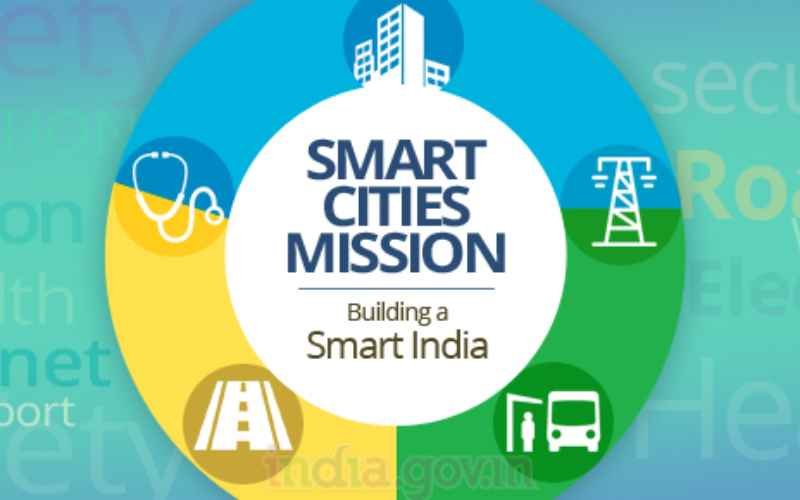In a world marked by rapid urbanization and technological advancements, the concept of a “smart city” has emerged as a beacon of innovation and sustainability. In India, the Smart Cities Mission, spearheaded by the Government, stands as a testament to the nation’s commitment to transforming its urban landscape into hubs of efficiency, connectivity, and prosperity.

Understanding the Smart Cities Mission
The Smart Cities Mission is a visionary initiative introduced by the Government of India in 2015 with the ambitious goal of transforming urban landscapes across the nation. At its core, the mission aims to harness the power of technology and innovation to create cities that are not only efficient and sustainable but also responsive to the needs and aspirations of their citizens.
One of the key objectives of the Smart Cities Mission is to address the myriad challenges faced by rapidly growing urban areas, including issues like traffic congestion, air and water pollution, inadequate infrastructure, and uneven access to basic services like healthcare, education, and sanitation. By integrating cutting-edge technologies such as Internet of Things (IoT), artificial intelligence (AI), and data analytics, these cities aspire to become more intelligent and interconnected, enabling better management of resources and improved service delivery.
Moreover, the Smart Cities Mission emphasizes citizen participation and engagement as fundamental principles in the planning and implementation process. Through platforms like citizen feedback mechanisms and participatory budgeting, residents are encouraged to actively contribute to decision-making and shape the future of their communities.
Each smart city under the mission is envisioned as a dynamic ecosystem where various stakeholders – government bodies, businesses, academia, and citizens – collaborate synergistically to co-create innovative solutions to urban challenges. These cities serve as living laboratories for experimentation and learning, paving the way for scalable and replicable models of urban development that can be adopted across the country and beyond.
Key Components of the Smart Cities Initiative
- Infrastructure Development: At the heart of the Smart Cities Mission lies the development of robust infrastructure, including smart transportation systems, efficient waste management, reliable water supply, and sustainable energy solutions. By integrating cutting-edge technology with traditional infrastructure, cities can optimize resource utilization and improve service delivery.
- Digital Transformation: Central to the concept of smart cities is the integration of digital technologies to enhance governance, service delivery, and citizen engagement. Through initiatives like e-governance platforms, mobile applications, and IoT-enabled infrastructure, cities can streamline operations, facilitate transparency, and empower citizens to actively participate in decision-making processes.
- Sustainability and Resilience: Smart cities prioritize sustainability and resilience to mitigate the impact of climate change and environmental degradation. From green building initiatives and renewable energy projects to urban planning strategies that promote walkability and green spaces, these cities aim to create a harmonious balance between economic growth and environmental conservation.
- Inclusive Development: One of the core principles of the Smart Cities Mission is ensuring inclusive development that caters to the needs of all segments of society, including marginalized communities and persons with disabilities. By fostering social equity and accessibility, smart cities strive to create an environment where everyone can thrive and contribute to the city’s prosperity.
Challenges and Opportunities
The Smart Cities Mission in India indeed presents a promising vision for urban development, but it’s accompanied by a set of challenges that need to be addressed to realize its full potential. Let’s explore these challenges and the opportunities they present:
- Funding Constraints: One of the primary challenges facing the Smart Cities Mission is securing adequate funding for the implementation of ambitious projects. Limited public resources and competing priorities often hinder the development of necessary infrastructure and technology upgrades. However, this challenge also underscores the opportunity to explore innovative financing mechanisms such as public-private partnerships (PPPs), municipal bonds, and international collaborations to mobilize additional funds for smart city projects.
- Technological Barriers: The adoption of advanced technologies like IoT, AI, and data analytics poses technical challenges related to interoperability, data privacy, cybersecurity, and digital literacy. Overcoming these barriers requires investment in research and development, capacity building, and the establishment of robust regulatory frameworks. However, addressing these challenges presents an opportunity to foster indigenous innovation, build local technological capabilities, and drive digital transformation across sectors.
- Regulatory Hurdles: Complex regulatory frameworks and bureaucratic processes often impede the timely implementation of smart city projects. Streamlining regulations, promoting regulatory sandboxes for testing new technologies, and establishing clear guidelines for public-private partnerships can facilitate smoother project execution. Moreover, regulatory challenges offer an opportunity to advocate for policy reforms that promote innovation, competition, and sustainable urban development.
- Stakeholder Collaboration: Effective collaboration between government agencies, private sector partners, academic institutions, and civil society organizations is essential for the success of the Smart Cities Mission. However, coordinating diverse stakeholders with varying interests, priorities, and expertise can be challenging. Building strong partnerships, fostering a culture of transparency and trust, and creating platforms for meaningful engagement and dialogue can enhance collaboration and drive collective action towards common goals.
While these challenges may seem daunting, they also present opportunities for innovation, collaboration, and knowledge exchange. By leveraging India’s entrepreneurial spirit, technological prowess, and rich cultural heritage, the Smart Cities Mission has the potential to not only address urban challenges but also serve as a model for sustainable and inclusive development on a global scale. Embracing these opportunities and overcoming the associated challenges will be crucial in realizing the transformative vision of smart cities in India.
The Road Ahead
Looking ahead, India’s pursuit of smart cities demands a comprehensive strategy that integrates innovation, sustainability, and inclusivity into every facet of urban development. Here’s a roadmap for the journey:
- Embrace Innovation: India must continue to embrace innovation as a driving force behind smart city development. This entails investing in research and development, fostering a culture of entrepreneurship and experimentation, and leveraging emerging technologies to address urban challenges creatively.
- Promote Sustainability: Sustainability should be at the forefront of India’s smart city agenda. This involves adopting eco-friendly practices in infrastructure development, promoting renewable energy sources, implementing green building standards, and prioritizing sustainable transportation solutions to reduce carbon emissions and mitigate climate change impacts.
- Foster Public-Private Partnerships (PPPs): Collaboration between the public and private sectors is vital for the success of smart city initiatives. By forging strong partnerships, governments can leverage the expertise, resources, and innovation capabilities of the private sector to accelerate the implementation of smart city projects while ensuring transparency, accountability, and equitable access to services.
- Prioritize Citizen-Centric Solutions: Putting citizens at the center of decision-making processes is crucial for building smart cities that truly serve the needs of their residents. This involves engaging citizens in the planning, design, and evaluation of urban projects, leveraging technology to enhance public participation and feedback mechanisms, and prioritizing inclusivity to ensure that no one is left behind.
- Invest in Digital Infrastructure: Robust digital infrastructure forms the backbone of smart cities, enabling seamless connectivity, data exchange, and service delivery. India must continue to invest in building high-speed internet networks, expanding digital literacy programs, and deploying IoT-enabled systems to optimize resource management and enhance quality of life for residents.
- Ensure Resilience: Building resilience against natural disasters, pandemics, and other shocks is essential for the long-term sustainability of smart cities. This involves incorporating disaster risk reduction measures into urban planning, enhancing healthcare infrastructure and emergency response systems, and promoting community resilience through education and awareness programs.
By adopting this holistic approach and staying committed to innovation, sustainability, and inclusivity, India can pave the way for a brighter, more prosperous future for its urban population. As India’s smart cities continue to evolve, they have the potential to inspire and inform urban development efforts worldwide, setting a new standard for inclusive, sustainable, and technologically advanced cities in the 21st century.
In conclusion, the Smart Cities Mission represents a paradigm shift in how we conceptualize and design urban spaces. By embracing innovation, sustainability, and inclusivity, India has the potential to not only build smarter cities but also create a better future for generations to come. As we navigate the complexities of urbanization and technological advancement, let us strive to build cities that are not only smart but also compassionate, resilient, and equitable.
Top FAQs
1. What is the Smart Cities Mission?
The Smart Cities Mission is an initiative launched by the Government of India in 2015 with the aim of developing 100 smart cities across the country. These cities integrate technology and data-driven solutions to enhance quality of life, sustainability, and efficiency.
2. How are cities selected for the Smart Cities Mission?
Cities are selected through a competitive process based on their proposals, which outline their vision, goals, and strategies for becoming smart cities. Criteria include feasibility, citizen engagement, and sustainability.
3. What are the key components of a smart city?
Key components include infrastructure development, digital transformation, sustainability and resilience, and inclusive development. This encompasses smart transportation, efficient waste management, digital governance, green initiatives, and accessibility for all.
4. How does the Smart Cities Mission impact citizens?
The mission aims to improve citizens’ lives by providing better infrastructure, services, and governance. This includes enhanced mobility, access to utilities, improved public safety, and increased citizen engagement through digital platforms.
5. What role does technology play in smart cities?
Technology plays a crucial role in smart cities, enabling data-driven decision-making, automation, and connectivity. It powers IoT devices, smart grids, e-governance platforms, and other innovations that enhance efficiency and quality of life.
6. How does the Smart Cities Mission promote sustainability?
The mission promotes sustainability through initiatives like renewable energy projects, green building standards, waste management systems, and urban planning strategies that prioritize environmental conservation and resilience.
7. How are smart cities funded?
Smart cities are funded through a combination of government grants, public-private partnerships, loans, and revenue generated from projects. The government provides financial support while encouraging private investment and innovation.
8. What challenges do smart cities face?
Challenges include funding constraints, technological barriers, regulatory hurdles, citizen participation, cybersecurity risks, and the need for skilled manpower. Overcoming these challenges requires collaboration and innovative solutions.
9. How does the Smart Cities Mission address inclusivity?
The mission promotes inclusive development by ensuring access to services and opportunities for all citizens, including marginalized communities and persons with disabilities. This involves designing infrastructure and policies that are equitable and accessible.
10. How are citizens involved in the Smart Cities Mission?
Citizen engagement is a key aspect of the mission, with opportunities for feedback, participation in decision-making processes, and access to information through digital platforms, town hall meetings, and community outreach programs.
11. What is the timeline for the completion of the Smart Cities Mission?
The mission was launched in 2015 with a target to develop 100 smart cities by 2023. However, the timeline may vary depending on factors such as funding, project complexity, and implementation challenges.
12. How are data privacy and security addressed in smart cities?
Data privacy and security are addressed through measures such as encryption, secure networks, access controls, and compliance with data protection regulations. Smart cities also prioritize transparency and accountability in data handling.
13. What role do public-private partnerships play in smart city development?
Public-private partnerships (PPPs) are vital for financing, implementing, and maintaining smart city projects. They leverage the expertise and resources of both sectors to deliver innovative solutions and share risks and rewards.
14. How are smart cities resilient to natural disasters and emergencies?
Smart cities incorporate resilience measures such as early warning systems, disaster preparedness plans, resilient infrastructure, and community engagement to mitigate the impact of natural disasters and emergencies.
15. How do smart cities promote economic growth and innovation?
Smart cities stimulate economic growth and innovation by attracting investment, fostering entrepreneurship, creating jobs, and providing a conducive environment for research, development, and technology adoption.
16. Can existing cities be retrofitted to become smart cities?
Yes, existing cities can be retrofitted with smart infrastructure and technologies to improve efficiency, sustainability, and quality of life. Retrofitting involves upgrading existing systems and integrating new solutions gradually.
17. How do smart cities improve transportation and mobility?
Smart cities improve transportation and mobility through initiatives such as intelligent traffic management systems, public transportation upgrades, last-mile connectivity solutions, and promoting non-motorized modes of transport.
18. What are some successful examples of smart city projects in India?
Successful examples include the Integrated Command and Control Centers (ICCCs), smart street lighting projects, waste management systems, e-governance platforms, and sustainable urban development initiatives implemented in various cities.
19. How are smart cities addressing environmental challenges such as air pollution and climate change?
Smart cities address environmental challenges through measures such as promoting clean energy, reducing emissions, enhancing green spaces, implementing eco-friendly transportation options, and raising awareness about sustainability.
20. How can citizens contribute to the success of smart cities?
Citizens can contribute by actively participating in community initiatives, providing feedback to authorities, adopting sustainable practices, leveraging digital services, and promoting a culture of civic responsibility and cooperation.
Related posts:
 AMRUT Strategy Scheme: Transforming Urban India
AMRUT Strategy Scheme: Transforming Urban India
 Skill India Mission
Skill India Mission
 Brightening Lives: Unraveling the Ujala Yojana
Brightening Lives: Unraveling the Ujala Yojana
 Empowering India Digitally: A Vision for the Future
Empowering India Digitally: A Vision for the Future
 Prime Minister Ujjwala’s Plan: A Boon for Rural India
Prime Minister Ujjwala’s Plan: A Boon for Rural India
 Adam Harrison Death Reason
Adam Harrison Death Reason
 SBI MCap: Harvesting Wealth – SBI Stock Surges 10% in a Day, Achieves Rs 8 Lakh Crore Milestone
SBI MCap: Harvesting Wealth – SBI Stock Surges 10% in a Day, Achieves Rs 8 Lakh Crore Milestone
 Atal Pension Yojana: A Step Towards Financial Security in Old Age
Atal Pension Yojana: A Step Towards Financial Security in Old Age
 Gold Monetisation Scheme (GMS): A Comprehensive Guide
Gold Monetisation Scheme (GMS): A Comprehensive Guide